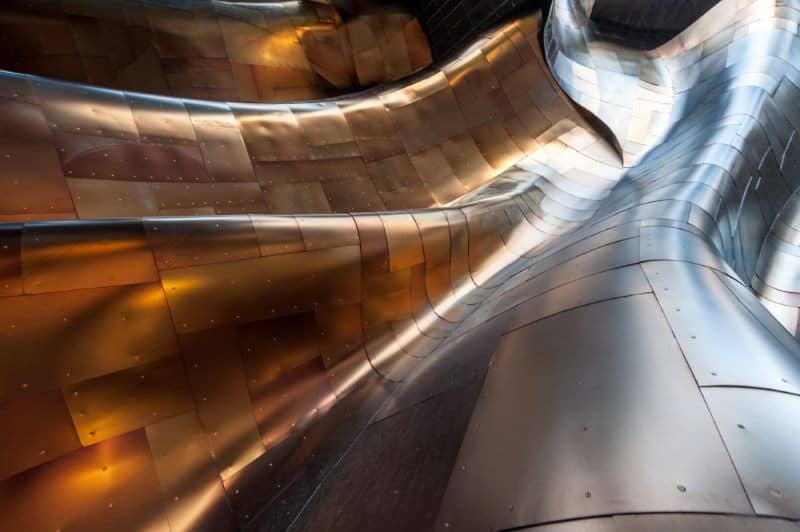Maybe you have some jewelry made from some of these metals and noticed that after some time, you’re getting greenish buildup, or that it’s turning your skin green. Or maybe you heard that the Statue of Liberty is made of copper, and yet it’s entirely green. The answer is pretty interesting.
Why do brass, bronze and copper turn green? All of these metals contain copper. When copper reacts with oxygen, it oxidizes and generates a greenish-blue layer that protects the metal from further corrosion. Any metal that contains a high amount of copper can turn green.
Actually, this green layer has a number of benefits, and it’s often used intentionally.
Table of Contents
Why Brass, Bronze and Copper Turn Green
Put simply, the most common copper oxide is green (yes, there are a few different kinds!).
Copper oxide is kind of like “rust”, although rust is the word that’s use to define iron oxide. That means that if there’s no iron, there’s no rust. But both are types of oxides.
When you see that green layer on these metals (usually called patina or verdigris) it’s because of a chemical reaction. The copper has reacted with oxygen, water, and carbon dioxide in the atmosphere.
Brass is an alloy that’s usually made up of 67% copper and 33% zinc. Bronze is composed of 88% copper and 12% tin.
Both of these metals have a really high copper content, which is why they form that same patina when they oxidize.
What Copper Oxide is Good For
Patina finishes are actually pretty popular for things like brass door handles, copper roofing, and other kinds of ornamental pieces. But beyond cosmetics, there are some practical reasons why you might want it.
For one, this adds a protective layer to the metal.
Copper oxide is an interesting substance. It adheres really well to the base metal, and it’s pretty durable. The thicker the copper oxide layer gets, the more it will resist further corrosion.
It’s nothing like iron oxide, which flakes off, exposes new metal, which then rusts, then flakes off, etc. The result is that rust can eat away entire structures over time.
That’s what makes copper oxide so cool. It’s oxidation that prevents oxidation.
One example is the Statue of Liberty, built in 1886. Over 130 years of being exposed to the elements later, the thickness of the copper oxide layer is only 0.005 of an inch! That’s about the thickness of two pieces of paper.

What Copper Oxide Isn’t Good For
There are many situations where you don’t want this patina.
For example, you probably don’t want your skin turning green if you have jewelry with copper in it. Or you might just prefer the bright look of copper instead of the dull greenish color of the patina.
Copper oxide also doesn’t conduct electricity. Since copper is a popular material for things like wires and electrical connections, oxidation is a complete pain in the backside.
How to Turn Copper Green
Ok, so copper (and metals with a lot of copper in them) will eventually turn green on their own by just being exposed to air and water. But what if you want to speed this process up?
Here’s one way to get small pieces of copper covered in a patina faster:
First off, clean the metal thoroughly with a degreaser. Any oils will end up protecting the metal from oxidizing and turning green.
Fill a sealable glass jar 1/4 of the way up with ammonia.
String the copper up and hang it in the jar just above the ammonia. Seal the jar. The ammonia fumes will create a thin patina within a few hours. If you want a thicker patina, just leave it in there for longer.
Cleaning is an extremely important step if you want to do it right the first time. If you don’t have it perfectly clean, the patina finish won’t be consistent. It’s not a major problem, though, since you can just clean it again and redo the process.
Pro Tip: Do this in a well ventilated area. Ammonia is pretty noxious stuff.
How to Remove Copper Oxide
It’s actually really easy to remove, and there are a whole slew of ways that you can do it.
For example, if you’re trying to remove the green oxide from coins like pennies, you can just soak them overnight in an acid. Pretty well everyone has seen this exact trick using Coca-Cola.
Aside from that, simple cleaning and scrubbing will get rid of the patina. There are also several cleaning products (usually which contain some kind of acid) that are specifically for cleaning copper-containing metals. You could also just use an abrasive pad (like Scotchbrite) if the copper has a brushed finish.
For cleaning electrical connections, usually a wire brush and a strong, acidic copper cleaner will make quick work of the problem.
Copper oxide is actually really dangerous for cookware. It’s toxic and you don’t want it mixing in with your food. Copper cookware is pretty popular, too. This means that you need to maintain it regularly. Since it’s usually polished, you’ll need some special cleaning supplies like this one.
If the problem is just a bit of tarnish more so than the green oxide, using household acids like lemon juice and a sponge will usually remove the problem areas without too much trouble. It would be a good idea to polish any copper with an inhibitor afterwards, since acids can etch the metal and leave it prone to oxidizing in the future.
How to Prevent Copper Oxide from Forming
The simplest way to keep copper, brass, and bronze from turning green is to just clean it regularly. It can take several weeks for the patina to form under average conditions.
That said, maintenance is a pain. So if you don’t want to have to remember to clean your copper, there are some alternatives.
Clear coat options are the most popular for things like hardware and jewelry. This is an example of one that will protect copper from tarnishing or forming a patina. Honestly, though, there are hundreds of products out there that are designed to keep copper looking bright.
Clear nail polish can also work well to protect copper. This is more popular for things like jewelry, but it doesn’t last as long as a proper hard clear coat.
A very old-fashioned way of preserving copper is by polishing it with beeswax. It takes a bit of elbow grease, but it does a very good job of protecting the metal from moisture and oxygen.
Related Questions
Why does copper turn green on skin? Copper will react with air, sweat, lotions, soaps, and any other types of chemicals that we expose our skin to. With prolonged contact, the patina formed can actually stain your skin! To avoid it, apply a simple coating to provide a barrier, which will prevent the copper from oxidizing.
Is copper jewelry safe to wear? Copper jewelry is totally safe. You won’t absorb enough through your skin to do any damage. Actually, some people claim that copper jewelry has health benefits. These include things like relief from headaches and arthritis, joint pain, and zinc deficiencies.
How long does it take for copper to turn green? This is extremely relative. In very dry conditions, copper can take up to 20 years to turn green! It also changes color in stages. At first, the copper will turn dull like a penny. Then brown, then darker brown, and finally it will start to turn green. With ammonia vapor, this could happen in only a few hours.

